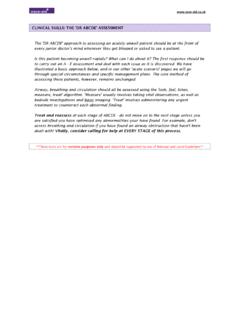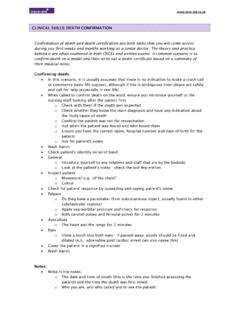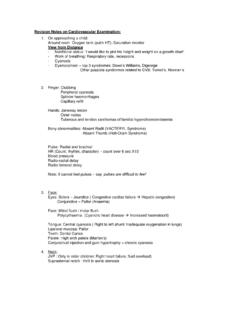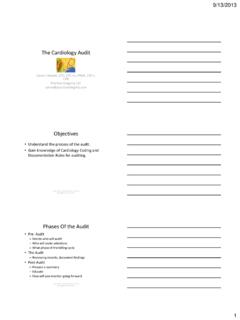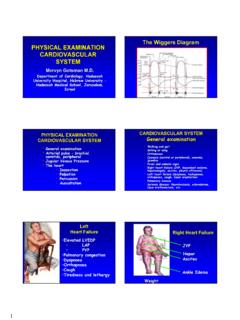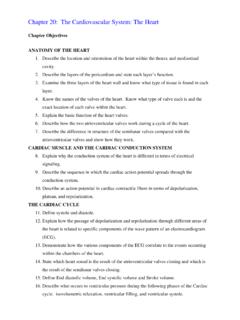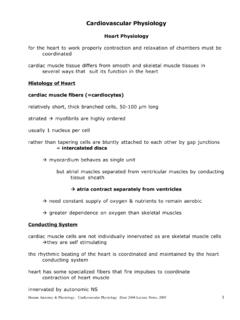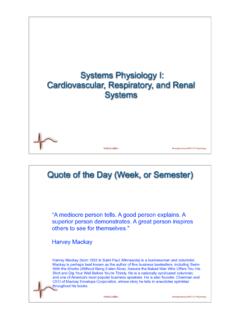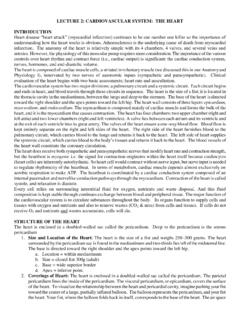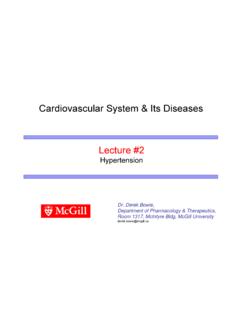Transcription of Cardiology cases or, Murmurs for Dummies - OSCE-Aid : the ...
1 Cardiology CasesDr AkishLuintelCardiology SpR Whittington HospitalDr Andrew Constantine Cardiology SpR Hammersmith Hospital Outline Simple overview of Murmurs How to present Key questions case examplesWhat comes up?Common finals casesProsthetic valvesASMRARA dult congenital heart diseaseMVPVSD/ASDR arer finals casesMSCCF without murmurHOCMM arfans (+AR)Turners (+AS)DextrocardiaWeak pulse(s)Normal examinationInspection is key This exam can be done in 5 minutes Always remember the BP it will give you a clue There may be a clue in the question, often you can make the diagnosis at the end of the bedside. Look at the arm pits, is there an PPM? Look for scars, look for a picc line Downs Syndrome (AS), Marfans Syndrome (AR, MR), Turners Syndrome + Noonan s syndrome (co-arctation or AS), Ankylosing Spondylitis (AR) Important points in the exam Collapsing pulse this is almost diagnostic of AR in exams Radial Radial delay Palpate the apex, if its not there feel on the right!
2 ! Listen to the bases of the lungs, swollen ankles heart failure is an important negative Ask your patient to sit forward and listen in expiration-> ~Early Diastolic murmur (this is the time to listen to the lungs) Ask your patient to roll to the left hand side -> Mitral StenosisMurmursAuscultatingAorticPulmona ryTricuspidMitral 1stheart sound T+M valve closing 2ndHeart sound A+P valve closing Palpate carotid while listeningIn simple is it loudest? or diastolic? Stenosis/ Mitral Regurgitation/ Metallic Valve and then the others In simple terms:Aortic?Systolic?StenosisDiastolic? RegurgitationPulmonary?Systolic?Stenosis Diastolic?RegurgitationMitralSystolic?Re gurgitationDiastolic?StenosisTricuspidSy stolic?RegurgitationDiastolic?StenosisDi fferentialsESMA ortic stenosisPulmonary stenosisAortic sclerosisHOCMA ortic flow murmurPSMM itral regurgitationTricuspid regurgitationVSDEDMA ortic regurgitationPulmonary regurgitationMDMM itral stenosisTricuspid stenosisAustin-FlintAtrial myxoma Four kinds of murmur:Ejection-systolic murmur (ESM)Pansystolic murmur (PSM)Early diastolic murmur (EDM)Mid-diastolic murmur (MDM)Presentation template I have examined the cardiovascular system of Mr X.
3 Peripherally there was _____. The apex beat was_____. On auscultation, there was _____ murmur loudest in the _____ region and accentuated by *manoeuvre*and *inspiration/expiration*. These findings are consistent with a diagnosis of _____. Presentation template 2 This 65 year old has a diagnosis of x, this is evidenced by the following positive , 2,3. Of note there was no evidence of infective endocarditis or heart failure. Prosthetic ValvesProsthetic ValvesMechanical vs. bioprostheticIf you can hear it, it s mechanicalTYPESM echanical prosthesesBall and cage (Starr-Edwards)Single tilting disc (Medtronic-Hall, Bjork-Shiley)Double-tilting disc (St Jude s)BioprosthesesXenografts (porcine, pericardial)Homografts (cadaveric)Prosthetic Valves In the ExamScars? Associated with a CABG?
4 Tunneled line? Endocarditis?Bruising?Jaundice?Why would someone have a valve replacement? Age-Young= Rheumatic fever, endocarditis, congenital heart disease, Severe valvularheart disease Older= Senile calcification (AS), Infection as above , Severe valvularheart diseaseProsthetic Valves -ComplicationsThromboembolismComplicatio ns of anticoagulation bleedingValve dysfunction (leakage, dehiscence, obstruction) ANY PROSTHETIC VALVE REGURGITANT MURMUR SHOULD BE REGARDED AS VALVULAR DYSFUNCTION UNTIL PROVEN OTHERWISE EndocarditisHaemolysisMechanical vs Tissue valve Mechanical valves last longer You need to warfarinise patients with mechanical valves Aortic valve-INR , Mitral Valve : 3 Prosthetic Valves In the ExamAortic or mitral prosthesis?Depending on the type of valve, there will be 1 or 2 audible clicksTime the closing (louder) click to the heart sounds (loudest click=closing valve)Pacemakers are more commonly associated with AVRsClick immediately preceding carotid= MitralClick following carotid = Aortic valve Two clicks= Double valveS1S2 Opening clickClosing clickS1S2 Opening clickClosing clickAORTICMITRALP rosthetic Valves In the ExamPresenting a AVR using the patient appears comfortable at rest and is haemodynamicallystable are no peripheral stigmata of pulse rate is 70 beats per minute, regular with normal volume and character.
5 The blood pressure is 125 venous pressure is not prosthetic click can be heard at the bedside. On examination of the preacordiumthere is a midline sternotomyscar. The apex beat is are no heaves or auscultation the first heart sound is followed by a prosthetic click at the second heart lung bases are clear and there is no peripheral is no evidence of of my list of differentials would be an AVR, which seems to be functioning wellQuestions Why would someone have a prosthetic valve? Tell me some of the complications associated with a prosthetic valve? What anticoagulation would you give with someone with a prosthetic valve? What are the causes of anaemia in a prosthetic valve?Aortic stenosisAortic stenosis Peripheral: narrow pulse pressure, slow-rising pulse, thrusting apex beat Auscultation: Harsh ESM, radiates to carotids, first heart sound is normal and second is soft / not present Loudest in: Aortic area, leaning forward, expiration.
6 Note Aortic Stenosis is often heard all over the praecordium. Presentations The pulse rate is 60 beats per minute and regular. It is of a slow rising character. The BP is 100/80 with a narrow pulse pressure. On examination of the praecordium there is an ejection systolic murmur, heard loudest over the aortic area which radiates to the carotids. It is heard best on expiration and leaning the patient forward. The second heart sound is soft. The JVP is not elevated, the lung fields are clear, and there is no peripheral oedema nor stigmata of endocarditis. This is Aortic Stenosis, my This patient has a diagnosis of Aortic Stenosis as evidenced by a slow rising pulse, an ejection systolic murmur heard loudest in the aortic area which radiates to the carotids. He/she has a narrow pulse pressure with a BP of 100/80, and is in a regular rhythm.
7 There is no evidence of heart failure or endocarditis. Presentation tips Always mention relevant negatives in valvular heart disease, heart failure and endocarditis. Low volume pulse and slow rising pulse are signs of severe aortic stenosis but the lack of a second heart sound is most important (when assessing severity) Remember the left ventricle is hypertrophied, so the LV shouldn t be displaced (unless very late on). Sometimes the murmur is loudest in the apex ???!!, This is Gallavardins phenomenon Differentials?Aortic sclerosis, HOCM, Pulmonary stenosis and SYSTOLIC Murmurs CongenitalBicuspid valveDownsNoonans/TurnersWilliamssyndrom eCo-arctation of aorta AcquiredCalcificationRheumatic feverInfective endocarditisAortic stenosis Differentials Aortic sclerosis-overlaps with aortic stenosis VSD-Very loud murmur, all over praecordium, maximal at sternal edge-young HOCM-Younger patient, louder in pulmonary area, worse on crouching , pansystolic-young Pulmonary Stenosis rare, normal second heart sound, louder on inspiration Mitral regurgitation if you hear it all over the praecordium (might be both).
8 Aortic stenosis How would you investigate this patient? History and exam: symptoms of AS (angina, syncope, dyspnoea); underlying cause Bedside: ECG (LVH, arrhythmia), urine dip Bloods: FBC, U+E, LFT, CRP Imaging: CXR -LVH, pulmonary oedema, calcified valve Echo-Severity and LV function Consider angiogram if going for surgery Aortic stenosis How would you manage this patient? Conservative -regular follow-up, exercise, smoking cessation etc. Medical Diuretics to reduce SOB and preload Optimise cardiovascular risk factors (HTN, DM, cholesterol) Surgical Valve replacement (indications: symptomatic or dependent on severity and LVEF). TAVI / balloon valvuloplasty if not a good candidate Aortic StenosisIS IT SEVERE?Clinical signs of severe ASLow volume pulseSlow-rising pulseNarrow pulse pressureHeaving apexSystolic thrillReversed splitting of second heart soundSoft/absent A24thheart soundLate systolic peaking of a long murmurSigns of pulmonary HTN/left heart failureClinical signs not reflective of severityLoud murmurRadiation to carotidsObjective classifications of severityAortic valve area < cm2 Mean pressure gradient > 50 mmHg& symptoms!
9 Questions? How would you differentiate with aortic sclerosis?-Normal 2ndheart sound, no radiation to carotids, normal pulse character What are associated conditions?-Rectal bleeding-colonic polyps (Heyde s syndrome) What are the indications for surgery-See as beforeMitral Regurgitation Peripheral: ? Signs of endocarditis, usually in AF, Auscultation: Displaced and thrusting Apex, Pansystolic murmur loudest in the apex, radiates to axilla. Loudest: Apex, Pan-Systolic Murmur?Mitral RegurgitationTricuspid RegurigationSmall VSDA ortic Stenosis SignPure MRPure TRPulseNormal or jerkyNormalJVPN ormalGiant v wavesPalpationApical systolic thrillThrusting displaced apexParasternal systolic thrillParasternal heaveAuscultationPSM loudest in expirationRadiates to axillaPSM, Carvallo s sign, no radiation to axillaHepatomegalyNonePulsatile hepatomegalyMitral stable/ stigmata of rate/rhythm/ & 1 + 2 (3/4) : Where?
10 Loud? Manoeuvres? Radiation? fields and else that is obvious?? diagnosis is/ at the top of my differential/ my differential would failureHeart failure Peripheral:SOB, cool peripheries, cyanosis, pitting oedema, ascites Auscultate:S3, bibasal creps, wheezeCCF Without a MurmurAnnoying station!Make sure you:Look for any scars of heart surgery/graftingMeasure/ask for the blood pressureListen carefully to the lung basesLook at the level and distribution of oedemaDo not make up sounds you cant investigation is paramount (ECHO)Heart failure I have examined the cardiovascular system of Mr X. He was short of breath at rest. Peripherally he was coldand had evidence of cyanosis in his hands, as well as somepedal oedema. On auscultation, there were bibasal findings are consistent with a diagnosis of heart failure.
